Common names from other countries
>
Anguilliformes (Eels and morays) >
Muraenidae (Moray eels) > Muraeninae
Etymology: Gymnothorax: Greek, gymnos = naked + Greek, thorax, -akos = breast (Ref. 45335); fimbriatus: Named for Tamara Mikhailovna Ambrozhevich (Ref. 57775).
More on author: Bennett.
Environment: milieu / climate zone / depth range / distribution range
экология
морской; солоноватоводный ассоциированный с рифами; пределы глубины 0 - 50 m (Ref. 90102). Tropical; 30°N - 28°S
Indo-Pacific: Madagascar (Ref. 33390) to the Society Islands, north to southern Japan (Ref. 559), south to Queensland, Australia; throughout Micronesia.
Size / Вес / Возраст
Maturity: Lm ? range ? - ? cm
Max length : 93.4 cm TL самец/пол неопределен; (Ref. 121652); 87.2 cm TL (female); наибольший вес (опубликованные данные): 1.5 kg (Ref. 121652); наибольший вес (опубликованные данные): 1.5 kg
позвонки: 128 - 142. Adults pale with small black spots on face; black spots proportionally much larger in young (Ref. 30404).
Occurs in lagoons, reef flats and seaward reefs (Ref. 1602, 48635). Prefers protected inshore waters among dead corals, common in harbors and small caves (Ref. 30404). Probably nocturnal (Ref. 1602). Feeds on fishes and crustaceans (Ref. 9710). Possibly a protogynous hermaphrodite (Ref. 32169). Current age of a captive individual is 18 years, which exceeds 100 cm and approximately 10 lbs (owner Mark Palermo, pers. comm. 07/12). Minimum depth reported taken from Ref. 86942.
Life cycle and mating behavior
Maturities | размножение | Spawnings | Egg(s) | Fecundities | личинки
Protogyny unconfirmed (Ref. 84746).
Chen, H.-M., K.-T. Shao and C.T. Chen, 1994. A review of the muraenid eels (Family Muraenidae) from Taiwan with descriptions of twelve new records. Zool. Stud. 33(1):44-64. (Ref. 6934)
Статус Красного Списка МСОП (Ref. 130435)
CITES (Ref. 128078)
Not Evaluated
Угроза для людей
Harmless
Использование человеком
рыболовство: не имеет хозяйственного значения
дополнительная информация
инструменты
Специальные отчеты
Скачать в формате XML
ресурсы в Интернет
Estimates based on models
Preferred temperature (Ref.
115969): 24.9 - 29, mean 28 (based on 774 cells).
Phylogenetic diversity index (Ref.
82804): PD
50 = 0.5000 [Uniqueness, from 0.5 = low to 2.0 = high].
Bayesian length-weight: a=0.00040 (0.00027 - 0.00059), b=3.31 (3.20 - 3.42), in cm Total Length, based on LWR estimates for this species & Genus-body shape (Ref.
93245).
Trophic level (Ref.
69278): 4.0 ±0.67 se; based on food items.
устойчивость к внешним воздействиям (Ref.
120179): низкий, минимальное время удвоения популяции 4.5-14 лет (Preliminary K or Fecundity.).
Fishing Vulnerability (Ref.
59153): High vulnerability (57 of 100).
